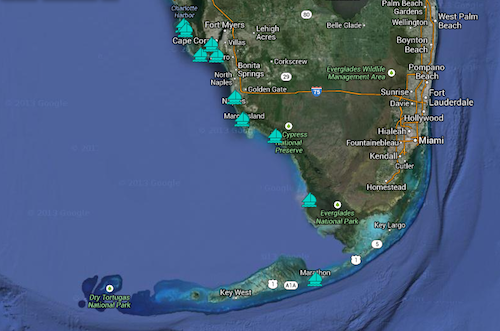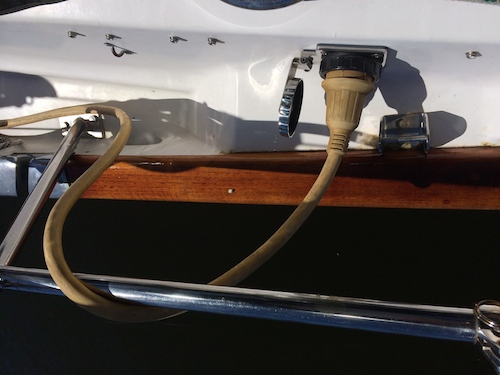Updating our ongoing refrigerator saga … if you’re new to this saga, two weeks ago, on the advice of a refrigeration tech, we removed the “speed resistor” from our Adler Barbour ColdPlate (not Cold Machine) which cut the energy use from 6 amps an hour to only 3 amps per hour. Several doubting thomases warned us that the ColdPlate would end up running twice as much — instead of 12 hours a day, every hour every day.
In the meantime, to complicate the equation, we installed a “spillover kit” between our refrigerator and the compartment to the side which used to be an “icebox”. By installing the fan in the “spillover kit” in the wall between the freezer and the “icebox” we more than doubled the size of our refrigeration compartments.

But 3 amps an hour is extremely compelling … especially when we have 225 watts of solar and a KISS wind generator, not enough to keep up with the 6 amps an hour for 12-14 hours a day we were experiencing…. or a total of 72 to 84 amps a day.

The bottom line is that by doubling the refrigeration space, the condenser now runs at 3 amps, 24 hours a day … we wanted to check it while we were anchored out to get a true reading on what it will do. The weather outside is warm – the last couple days have been 87 -89 degrees. 🙁 Not the miracle we had hoped.
But looking at it another way, we just gained 100% increase in our refrigerated area all for the exact same amps as we were using before. When you look at it that way, it seems we did decrease our amp usage by 1/2.

In the meantime, the “icebox” section of the new refrigerator leaks cold air like a sieve — out the top, out the front, everywhere. It’s almost like the galley is air conditioned … and it’s definitely NOT. 🙁 The addition doesn’t have the increased insulation of the refrigerated side. And even the added insulation of the refrigerated side is over 10 years old and looking more than a bit sad. So, before we decide this experiment didn’t really save us any amps, we’ll re-insulate the boxes and then try this experiment again.

Worst case, we put the speed resistor back in the thermostat and go back to using between 72-84 amps a day for our refrigeration — BUT we now have 100% more space, which was much much needed.
Best case, we add the insulation and can keep the speed resistor out and use somewhat less than 72 amps in a day to power our refrigeration. Keeping our fingers crossed!
In the meantime, the beer is cold, the fish is frozen solid and the fresh veggies are lasting a lot longer than before!
Any comments or insights into the best way to re-insulate our space? We’re thinking more stuff from Home Depot, need to go look. If you have any products you love and recommend, please leave a comment and let us know! THANKS! Jan & David














Home Depot sells a very small, hollow, half-round foam strip with double sided tape on the flat side. It will help seal the lids without raising them but a very small amount. Place them on the lip and the weight of the lid will seal better than not having it.
I added that to the lip on mine. I also added the magnetic rubber stripping out of an old refrigerator with a metal strip for it to mate against. That helped the most I think.
Can’t remember if you have a drain plug, but they help big time.
Drain plug? Duh! What a great idea. Yes, the icebox side has a drain and no we haven’t plugged it … until about five minutes from now! THANKS Jim, we appreciate the input. And we’ll look for the foam strip you found at Home Depot – and maybe we’ll look at a junkyard for some magnetic rubber stripping, yet another worthwhile idea. THANKS! Cheers! Jan & David
You’ll likely notice a HUGE difference once you plug the drain. We did. Relatively hot air from the bilge will rise into the fridge, and all that nice cold air in the fridge will fall into the bilge. A real duh! moment for us too when a friend told us to plug the drain 🙂
Jan, ive wondered about using expanding foam (like the “great stuff” brand) to fill the gaps and increase the foam around my icebox on Honfleur. I haven’t tried it yet, because the stuff is SO sticky, but im curious if it would be effective.
David’s wondered the same thing, but for the same reason has been hesitant to try it. But a friend on the next dock claims he’s going to use it this week in insulating his icebox. If he actually does it, I’ll try & remember to let you know. Cheers & Merry Christmas! Jan
I used it and it helped greatly. Be sure and only use the basic one as it does not put pressure on any structure it comes up against. The next grade up can break things if it runs out of space to expand!!!!
I bought the 4 inch rigid foam panel from home depot and cut it up with a razor and used liquid nails to bond it to the outer side of the icebox wherever i could access it from underneath on mine. also doubled the thickness of the cover, made it heavier but better insulation.
I did the same, adding as much as I could to those places that where accessible and blowing Great Stuff everywhere else.
You can use cheap clear plastic tubing over Great Stuff’s supplied pipe to reach spaces 2-4 feet away.
Using a measured about of ice to test, we went from having to replace it after 24 hours to keep the box below 39° to 4-5 days in hot weather (cabin temp 88° to 100°).
Thanks Jim! The re-insulating project is up next, just after changing out the batteries today. Always $umthing. 🙂 Cheers — Jan